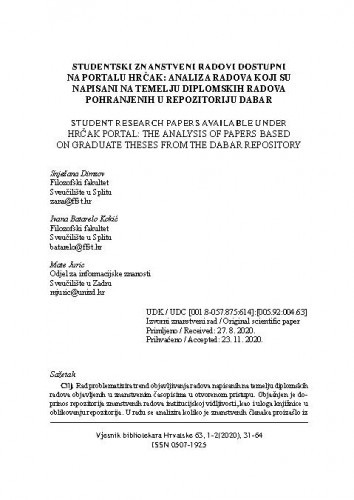Cilj. Rad problematizira trend objavljivanja radova napisanih na temelju diplomskih radova objavljenih u znanstvenim časopisima u otvorenom pristupu. Objašnjen je doprinos repozitorija znanstvenih radova institucijskoj vidljivosti, kao i uloga knjižnice u oblikovanju repozitorija. U radu se analizira koliko je znanstvenih članaka proizašlo iz diplomskih radova studenata triju filozofskih fakulteta te se utvrđuje učestalost pristupa i preuzimanja diplomskih i znanstvenih radova i njihovu citiranost. Istražuje se koliko je vremena potrebno da bi se diplomski rad pretvorio u članak i koje su prevladavajuće kategorizacije tih članaka. Pristup/metodologija/dizajn. Korišten je bibliometrijski pristup, uz metodu analize sadržaja koja je obuhvatila sljedeće pokazatelje: citiranost, zastupljenost znanstvenih radova po znanstvenim područjima, kategorizaciju radova, autorstvo, vrijeme objave te broj pregleda i preuzimanja radova. Polazište za istraživanje bili su svi diplomski radovi pohranjeni u repozitoriju Dabar na tri usporediva filozofska fakulteta u Splitu, Rijeci i Osijeku od 2013. do 2020. godine, ukupno 2791 rad. Nakon povezivanja diplomskih radova s proizašlim znanstvenim radovima objavljenim na portalu Hrčak testirane su razlike u citiranosti i vidljivosti radova u dvama sustavima. Rezultati. Istraživanje je pokazalo da se približno 6 % diplomskih radova iz društvenog područja i 2 % radova iz humanističkog područja preoblikuje u znanstvene članke objavljene u časopisima dostupnim u otvorenom pristupu na portalu Hrčak. Većina znanstvenih članaka objavi se do dvije godine nakon pohrane diplomskog rada u repozitoriju. Objavom radova u časopisima dostupnim na portalu Hrčak značajno se poboljšava njihova vidljivost. Potvrđena je i važnost otvorenog pristupa diplomskim radovima u sustavu Dabar.Ograničenja istraživanja odnose se prije svega na početni odabir radova iz područja društvenih i humanističkih znanosti.; Purpose. The paper discusses the trend of publishing papers based on graduate theses in open access scientific journals. The contribution of the repository of scientific papers to institutional visibility is explained, as well as the role of the library in designing and maintaining the repository. The study focuses on the analysis of the number of scientific research papers that originated from the graduate theses of the students of the three faculties of humanities and social sciences, and the frequency of access and download of the graduate thesis, and scientific papers and their citations. Furthermore, it is explored how long it takes to turn a thesis into an article, and what are the predominant categorizations of these articles. Approach/methodology/design. A bibliometric approach is used, with the content analysis research method that included the following indicators: citations, representation of scientific papers by scientific fields, categorization of papers, authorship, date of publication, and the number of reviews and downloads. The starting point for the research were all graduate theses stored in the Dabar repository at three comparable faculties of humanities and social sciences in Split, Rijeka, and Osijek in the period from 2013 to 2020, a total of 2791 papers. After connecting the diploma theses with the resulting scientific papers published on the Hrčak portal, the differences in citations and visibility of papers in the two systems were tested. Findings. The research has shown that approximately 6% of diploma theses from the field of social sciences and 2% of papers from the humanities are transformed into scientific papers published in journals available on the Hrčak portal. Most scientific papers are published up to two years after the graduate thesis is stored in the repository. The publication of papers in the journals available on the Hrčak portal significantly improves their visibility.
Studentski znanstveni radovi dostupni na portalu Hrčak : analiza radova koji su napisani na temelju diplomskih radova pohranjenih u repozitoriju Dabar = Student research papers available under Hrčak portal : the analysis of papers based on graduate theses from the Dabar repository / Snježana Dimzov, Ivana Batarelo Kokić, Mate Juric.
Sažetak

 Vjesnik bibliotekara Hrvatske : 63,1-2(2020) / glavna i odgovorna urednica, editor-in-chief Kornelija Petr Balog.
Vjesnik bibliotekara Hrvatske : 63,1-2(2020) / glavna i odgovorna urednica, editor-in-chief Kornelija Petr Balog.